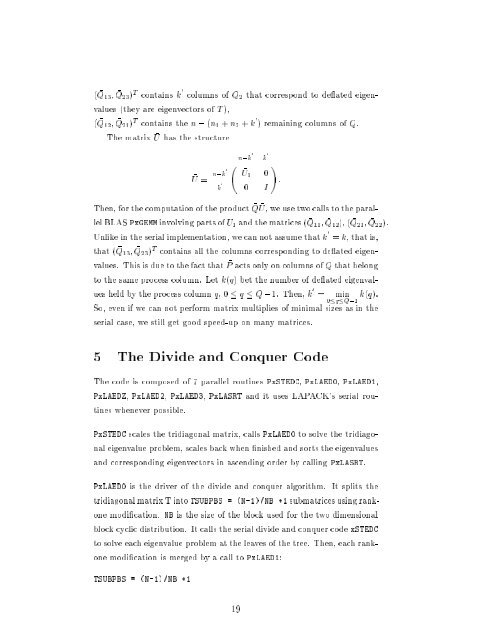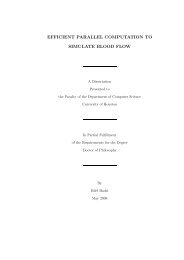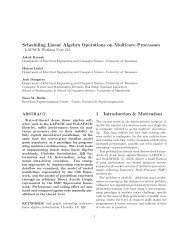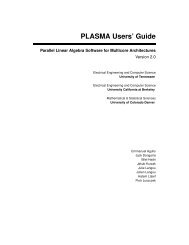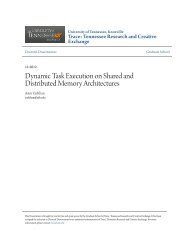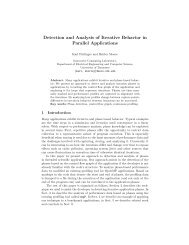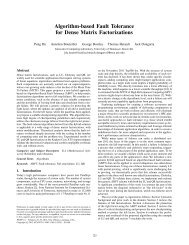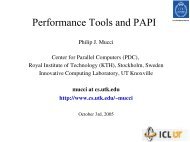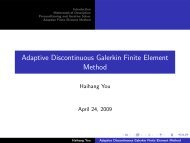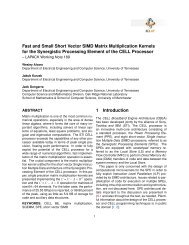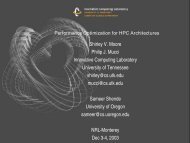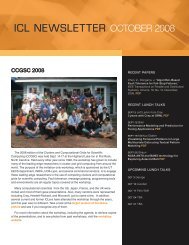Parallelizing the Divide and Conquer Algorithm - Innovative ...
Parallelizing the Divide and Conquer Algorithm - Innovative ...
Parallelizing the Divide and Conquer Algorithm - Innovative ...
Create successful ePaper yourself
Turn your PDF publications into a flip-book with our unique Google optimized e-Paper software.
( Q13; Q23) T contains k 0 columns of Q2 that correspond to deated eigenvalues<br />
(<strong>the</strong>y are eigenvectors of T ),<br />
( Q12; Q21) T contains <strong>the</strong> n , (n1 + n2 + k 0 ) remaining columns of Q.<br />
The matrix U has <strong>the</strong> structure<br />
U =<br />
n,k 0 k 0<br />
n,k 0 U <br />
1 0<br />
k 0 0 I<br />
!<br />
:<br />
Then, for <strong>the</strong> computation of <strong>the</strong> product Q U,we use two calls to <strong>the</strong> parallel<br />
BLAS PxGEMM involving parts of U1 <strong>and</strong> <strong>the</strong> matrices ( Q11; Q12); ( Q21; Q22).<br />
Unlike in <strong>the</strong> serial implementation, we can not assume that k 0 = k, that is,<br />
that ( Q13; Q23) T contains all <strong>the</strong> columns corresponding to deated eigenvalues.<br />
This is due to <strong>the</strong> fact that P acts only on columns of Q that belong<br />
to <strong>the</strong> same process column. Let k(q) bet <strong>the</strong> number of deated eigenvalues<br />
held by <strong>the</strong> process column q, 0qQ,1. Then, k 0 = min<br />
0qQ,1 k(q).<br />
So, even if we can not perform matrix multiplies of minimal sizes as in <strong>the</strong><br />
serial case, we still get good speed-up on many matrices.<br />
5 The <strong>Divide</strong> <strong>and</strong> <strong>Conquer</strong> Code<br />
The code is composed of 7 parallel routines PxSTEDC, PxLAED0, PxLAED1,<br />
PxLAEDZ, PxLAED2, PxLAED3, PxLASRT <strong>and</strong> it uses LAPACK's serial routines<br />
whenever possible.<br />
PxSTEDC scales <strong>the</strong> tridiagonal matrix, calls PxLAED0 to solve <strong>the</strong> tridiagonal<br />
eigenvalue problem, scales back when nished <strong>and</strong> sorts <strong>the</strong> eigenvalues<br />
<strong>and</strong> corresponding eigenvectors in ascending order by calling PxLASRT.<br />
PxLAED0 is <strong>the</strong> driver of <strong>the</strong> divide <strong>and</strong> conquer algorithm. It splits <strong>the</strong><br />
tridiagonal matrix T into TSUBPBS = (N-1)/NB +1 submatrices using rankone<br />
modication. NB is <strong>the</strong> size of <strong>the</strong> block used for <strong>the</strong> two dimensional<br />
block cyclic distribution. It calls <strong>the</strong> serial divide <strong>and</strong> conquer code xSTEDC<br />
to solve each eigenvalue problem at <strong>the</strong> leaves of <strong>the</strong> tree. Then, each rankone<br />
modication is merged by a call to PxLAED1:<br />
TSUBPBS = (N-1)/NB +1<br />
19


